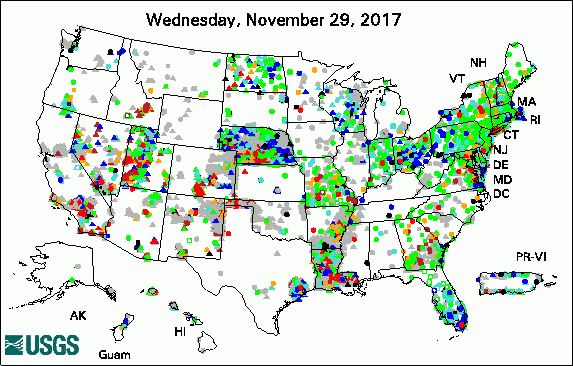USGS Groundwater Information
|
USGS Groundwater Information > January 2, 2018 Highlights USGS Monthly Groundwater News and Highlights: January 2, 2018Subscribe and get the latest USGS groundwater news and science sent to your inbox every month! Featured Product: Groundwater Quality in Four Principal Aquifers![Map of location and summary of water quality in U.S. principal aquifers [ Map of location and summary of water quality in U.S. principal aquifers ]](images/feature/20180102_pa_index_map.png)
Map of location and summary of water quality in U.S. principal aquifers. Source: USGS National Water Quality Program, 2017. Figure is in the public domain. USGS recently completed studies of groundwater quality in four U.S. Principal Aquifers. Almost one-half of the Nation's population relies on groundwater for drinking water. Regional assessments of groundwater quality are part of ongoing USGS efforts to assess, understand, and forecast the quality of the Nation's groundwater. These studies provide resource managers and policy makers with needed information on which to base sound decisions for water management.
USGS Groundwater-Related Press Releases 
The USGS Active Groundwater Level Network includes about 20,000 wells that have been measured by the USGS or USGS cooperators at least once within the past 13 months. The animation shows a daily snapshot of water-level statistics in the network for December 2017. Credit: USGS. The image is in the public domain. Groundwater Quality in the Midwest: The Cambrian-Ordovician Aquifer System (12/7/2017) Groundwater Quality in the North: The Glacial Aquifer System (12/7/2017) Groundwater Quality in the Southwest: The Rio Grande Aquifer System (12/7/2017) Groundwater Quality in the East: The Piedmont and Blue Ridge Crystalline-Rock Aquifers (12/7/2017) The Quality of the Nation's Groundwater: Progress on a National Survey (12/7/2017) Scientists Home in on Causes of High Radium Levels in Key Midwestern Aquifer (12/6/2017)
USGS Groundwater-Related PublicationsEnvironmental characteristics and utilization potential of metallurgical slag: Chapter 19 (12/11/17) Baseline Assessment of Groundwater Quality in Pike County, Pennsylvania, 2015 (12/29/17) Visualization of groundwater withdrawals (12/21/17) Groundwater quality in the Rio Grande aquifer system, southwestern United States (12/07/17) Groundwater quality in the glacial aquifer system, United States (12/07/17) Groundwater quality in the Cambrian-Ordovician aquifer system, midwestern United States (12/07/17) Colloid mobilization and seasonal variability in a semiarid headwater stream (12/05/17) Vulnerability of coral reefs to bioerosion from land-based sources of pollution (12/11/17)
USGS Groundwater-Related Software Updates and New Releases
USGS Groundwater Flow and Transport Model Data ReleasesNote: The following links take you to data.gov
Field PhotoDid you know that groundwater flowing into lakes can affect the quality of the lake water? Periphyton, a type of algae, is growing on bottom sediment and rocks along nearshore areas of Lake Tahoe in California. The periphyton is seen as a nuisance and negatively impacts the recreational value of the lake. The USGS Nevada Water Science Center is working with the University of Nevada-Reno, in cooperation with the Lahontan Regional Control Board, to investigate the relationships between periphyton biomass, the lake, and shallow groundwater surrounding Ward Creek, near Tahoe City, California. This USGS study demonstrates the important role of groundwater in delivering nutrients to the periphyton communities during the winter-spring growth period. In the first photo, hollow metal rods called piezometers installed in the lake bed are used to study lake and shallow groundwater conditions. The second photo shows diatoms attached to rocks along the west shore of Lake Tahoe. Archive of Past Highlights: |